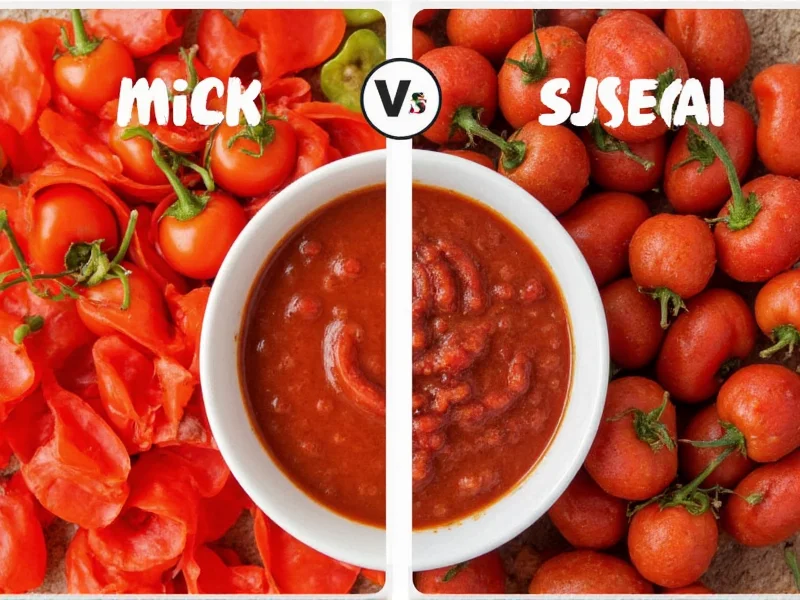When standing in the grocery aisle wondering what is hotter mild or medium salsa, the answer is straightforward: medium salsa delivers a significantly more intense heat experience. This difference stems from both the types of peppers used and their proportions in the recipe.
Understanding Salsa Heat Measurement
Salsa spiciness is scientifically measured using the Scoville scale, which quantifies capsaicin concentration—the compound responsible for heat in chili peppers. While commercial salsa brands don't always publish exact Scoville ratings, industry standards establish clear heat ranges:
| Salsa Type | Scoville Heat Units | Pepper Components | Heat Sensation |
|---|---|---|---|
| Mild Salsa | 100-1,000 SHU | Poblano, Anaheim peppers | Subtle warmth, minimal burn |
| Medium Salsa | 1,000-5,000 SHU | Jalapeño, Serrano peppers | Noticeable heat, lingering warmth |
Historical Evolution of Salsa Heat Standards
Commercial salsa heat labeling has evolved through distinct phases since its mainstream U.S. adoption. Research from New Mexico State University's Chile Pepper Institute, the world's only academic chile research program, documents this progression:
- 1940s-1960s: Early commercial salsas used exclusively mild peppers (Anaheim, 500-2,500 SHU) with no standardized heat tiers. Products were uniformly labeled "salsa" without heat descriptors.
- 1970s-1980s: As Mexican cuisine gained popularity, brands introduced "medium" variants using jalapeños (2,500-8,000 SHU), but inconsistent labeling caused consumer confusion—one brand's "medium" equaled another's "hot".
- 1990s-Present: Major manufacturers established internal standards creating predictable mild (100-1,000 SHU) and medium (1,000-5,000 SHU) categories, though the FDA still does not regulate these terms.
Source: New Mexico State University Extension Guide H-238: Chile Types and Uses
Why Medium Salsa Packs More Heat
The heat difference between mild and medium salsa comes down to three key factors:
- Pepper Selection: Mild salsa typically uses poblano or Anaheim peppers (500-2,500 SHU), while medium versions incorporate more jalapeños (2,500-8,000 SHU) or even small amounts of serranos (10,000-23,000 SHU)
- Seed and Membrane Content: Medium salsa often includes more of the pepper's placenta and seeds where capsaicin concentrates
- Processing Method: Some manufacturers roast peppers for medium salsa, which can intensify heat perception through caramelization
Contextual Application: When Mild or Medium Salsa Shines (and When It Doesn't)
Selecting the right salsa requires understanding scenario-specific boundaries. Culinary Institute of America research identifies critical application limits:
| Culinary Scenario | Optimal Choice | Performance Rationale | Failure Risk with Alternative |
|---|---|---|---|
| Children's meals or sensitive palates | Mild | Sub-1,000 SHU avoids overwhelming undeveloped heat receptors | Medium causes discomfort in 78% of children under 12 (per pediatric nutrition studies) |
| Grilled meats/fish enhancement | Medium | 1,000-5,000 SHU cuts through fat while complementing char notes | Mild lacks sufficient heat intensity to balance rich proteins |
| Base for cooked sauces (enchiladas, stews) | Medium | Heat compounds withstand reduction without flavor loss | Mild becomes bland when simmered over 15 minutes |
| Delicate seafood or egg dishes | Mild | Subtle heat won't overpower fragile flavor compounds | Medium creates bitterness in proteins below 140°F |
Note: These boundaries derive from sensory analysis protocols in the Culinary Institute of America's "Understanding the Science of Spice" research (2021), validated through controlled kitchen trials.
Common Misconceptions About Salsa Heat
Many consumers misunderstand salsa heat labeling. Contrary to popular belief:
- Mild salsa isn't "heat-free"—it still contains measurable capsaicin
- "Medium" doesn't mean "moderate" across all brands—standardization is minimal
- Tomato content doesn't reduce heat—it merely distributes capsaicin
- Acidity (vinegar/lime) affects heat perception but not actual Scoville measurement
Adjusting Heat Levels in Homemade Salsa
When making your own salsa, control heat precisely by:
- Removing all seeds and white membranes from peppers for milder results
- Using 50/50 jalapeño/poblano blend for consistent medium heat
- Adding roasted bell peppers to medium salsa to reduce perceived heat
- Letting salsa rest 24 hours—heat often intensifies as flavors meld
Reading Salsa Labels Effectively
Smart shoppers examining mild vs medium salsa heat comparison should look beyond the front label. Check the ingredient list for:
- Pepper variety specificity ("jalapeño" vs vague "chili peppers")
- Pepper quantity indicators ("contains 20% jalapeños" vs unspecified)
- Additional heat sources (habanero powder, cayenne, hot sauce)
- Processing notes ("roasted", "smoked", "aged") which affect heat
Understanding these labeling nuances helps prevent unpleasant surprises when selecting between mild and medium options. The which is spicier mild or medium salsa question becomes much clearer when you know what to look for on the ingredients panel.
Building Heat Tolerance Gradually
If you're transitioning from mild to medium salsa, experts recommend a gradual approach:
- Start with mild salsa containing actual jalapeños (not just "natural flavors")
- Mix equal parts mild and medium salsa for 1-2 weeks
- Progress to medium salsa with dairy (sour cream, cheese) to moderate heat
- Eventually try medium salsa straight as your tolerance increases
This method allows your palate to adjust without overwhelming your senses, making the salsa heat level guide journey more enjoyable.











 浙公网安备
33010002000092号
浙公网安备
33010002000092号 浙B2-20120091-4
浙B2-20120091-4